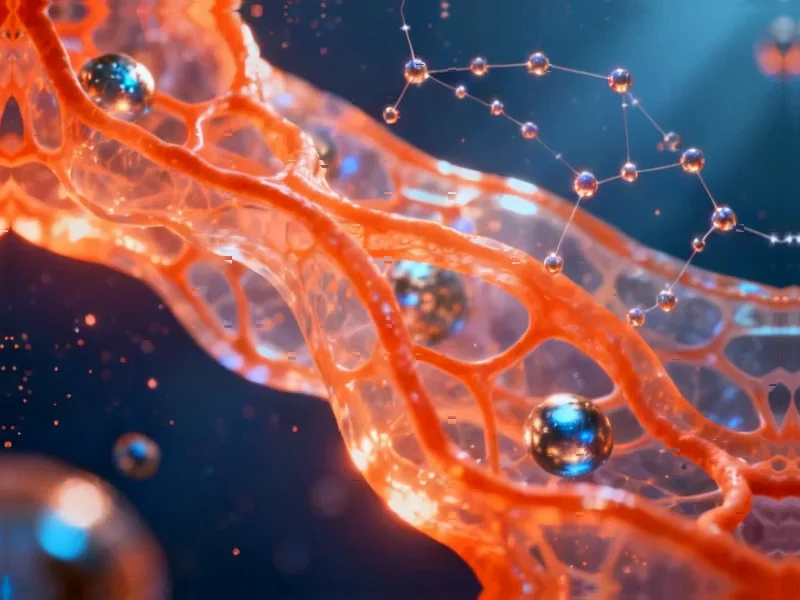Breakthrough in Dark Exciton Control
Scientists have developed a novel approach to activate and control dark excitons in tungsten diselenide (WSe₂) monolayers, according to recent research published in npj 2D Materials and Applications. The study reportedly demonstrates how plasmonic effects from metallic tips can brighten these typically non-radiative quantum states, overcoming fundamental limitations that have previously made them inaccessible for optical applications.
Table of Contents
The Challenge of Dark Excitons
Dark excitons represent a significant challenge in 2D material research, sources indicate. These quantum states, formed when electrons and holes bind together, remain optically inactive due to their unique symmetry properties and momentum conservation constraints. Analysts suggest that while bright excitons readily emit light and have been extensively studied, dark excitons have remained largely inaccessible despite their potential for quantum information applications.
The research team focused specifically on spin-forbidden dark (SFD) excitons in WSe₂ monolayers. According to the report, these excitons possess weak out-of-plane dipole moments and zero in-plane dipole moments, making them fundamentally dark under normal circumstances. The inability to control these states has limited their practical application in photonic and quantum devices.
Plasmonic Enhancement Mechanism
The breakthrough came from using a sharp gold tip to create localized electromagnetic field enhancements, the study states. Researchers reportedly employed both advanced computational methods, including solving the Bethe-Salpeter equation, and experimental approaches to understand how plasmonic effects could activate dark excitons.
Sources indicate that the metallic tip generates strong near-field enhancements, particularly in the nanogap region between the tip and substrate. This enhanced electric field along the z-axis compensates for the weak out-of-plane dipole moment of SFD excitons. The report suggests that the tip introduces additional in-plane momentum components that overcome the fundamental momentum mismatch preventing radiative emission.
Theoretical Framework and Computational Validation
To establish a comprehensive theoretical framework, researchers reportedly employed multiple computational approaches. The team used the computationally demanding Bethe-Salpeter equation for accurate excitonic property predictions, while also implementing the more practical Wannier-Mott exciton model for larger system simulations., according to emerging trends
According to the analysis, both methods showed good agreement in predicting exciton binding energies, though the Wannier-Mott model slightly underestimated values compared to BSE calculations. The researchers accounted for dielectric environment effects using the Rytova-Keldysh potential, finding that substrate choice significantly influences exciton binding energies.
Selection Rules and Symmetry Considerations
The research provides new insights into the dipole selection rules governing dark exciton activation, analysts suggest. Through group theory analysis and wavefunction projections, the team confirmed that dark exciton transitions are allowed between bands of opposite total spin due to spin-orbit coupling effects.
The report states that the ratio of dipole matrix elements between dark and bright excitons is approximately 3.5 × 10⁻³, explaining why dark excitons typically show negligible emission. However, the plasmonic tip enhancement reportedly overcomes this limitation by generating the necessary momentum components for radiative recombination.
Experimental Implications and Applications
This research opens new possibilities for controlling and detecting SFD excitons in near-field optical experiments, according to sources familiar with the work. The ability to selectively activate otherwise optically inactive excitons could enable new approaches in quantum information processing and optoelectronic device design.
The findings reportedly demonstrate that dark exciton radiative lifetimes can be controlled through careful engineering of the local electromagnetic environment. This control mechanism could prove valuable for developing quantum memory devices and single-photon sources based on 2D materials.
Researchers suggest that the approach could be extended to other transition metal dichalcogenides and potentially other 2D material systems where dark excitons play important but previously inaccessible roles in material properties and potential applications.
Reference links: Valence and conduction bands, Selection rules
Related Articles You May Find Interesting
- OpenAI’s ChatGPT Atlas Browser Struggles to Compete in AI Search Arena
- Commerce Department Denies Equity Negotiations with Quantum Computing Firms
- NordVPN Introduces DNS-Based Adult Content Filter Amid Age Verification Concerns
- Windows 11 Start Menu Overhaul Brings Enhanced Navigation and Personalization Op
- Canada Aims to Double Non-U.S. Exports Amid Trade Tensions, Carney Announces
References
- http://en.wikipedia.org/wiki/Valence_and_conduction_bands
- http://en.wikipedia.org/wiki/Substrate_(chemistry)
- http://en.wikipedia.org/wiki/Binding_energy
- http://en.wikipedia.org/wiki/Selection_rule
- http://en.wikipedia.org/wiki/Permittivity
This article aggregates information from publicly available sources. All trademarks and copyrights belong to their respective owners.
Note: Featured image is for illustrative purposes only and does not represent any specific product, service, or entity mentioned in this article.



